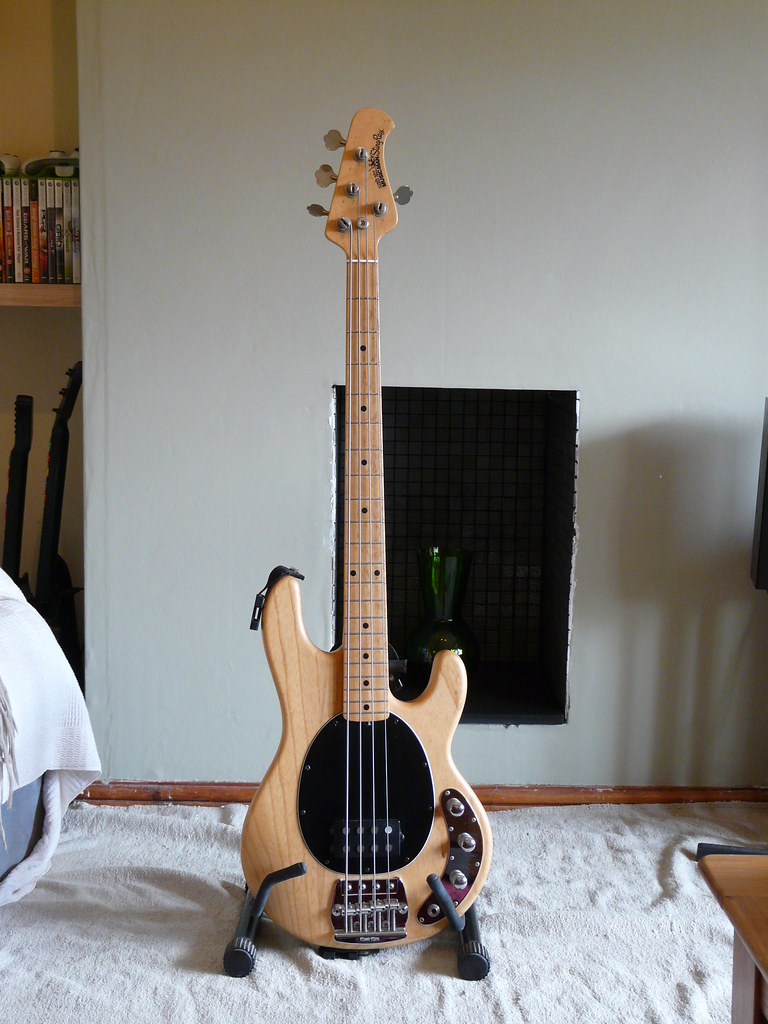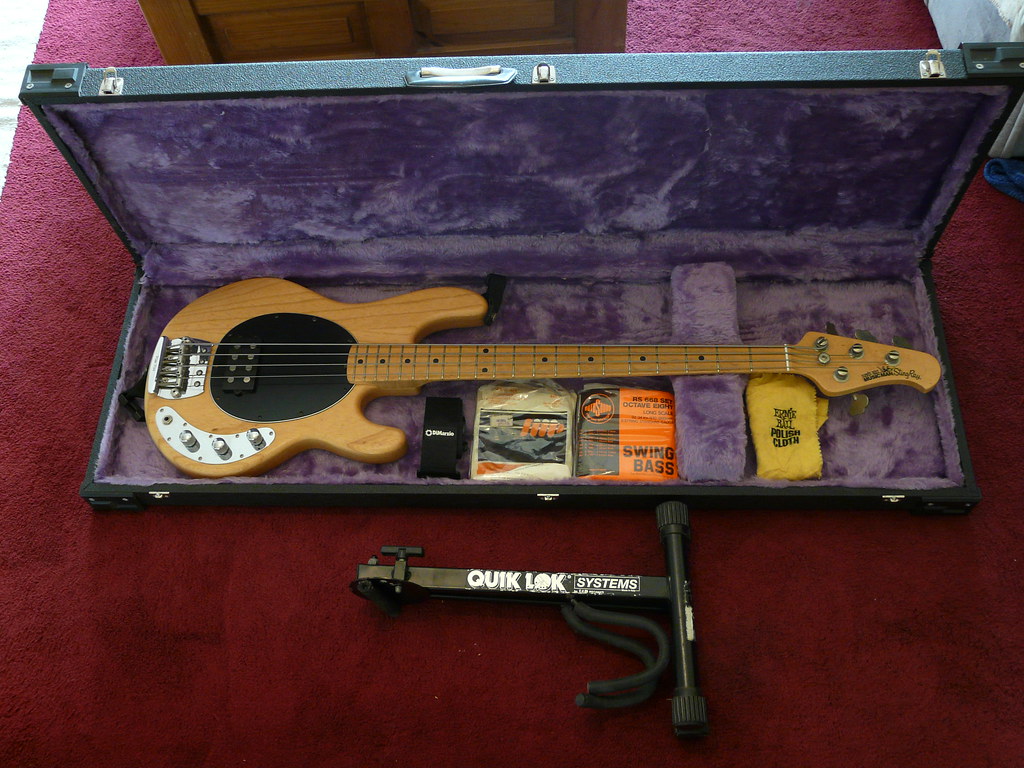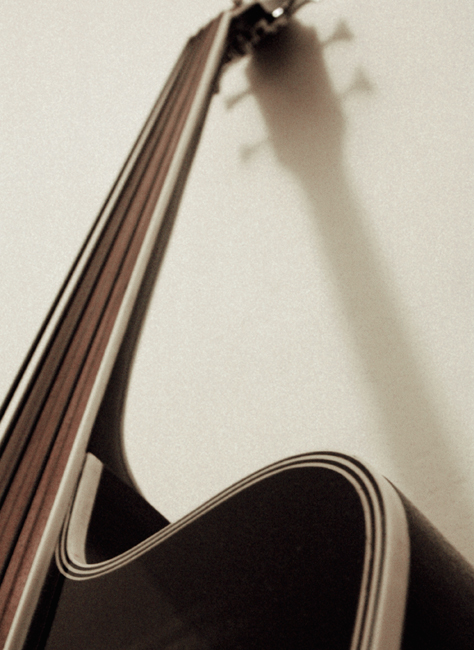- This topic has 22 replies, 14 voices, and was last updated 13 years ago by porter_jamie.
-
Calling all Bass guitarists
-
AmosFree MemberPosted 13 years ago
Just picked up my brother in laws bass to have a play with. If I get on OK with it I’ll get my own but figured borrowing one first was best.
So what is the best bass guitar tip you know for a complete newb!
thomthumbFree MemberPosted 13 years agoget funky!
erm. dunno find some easy songs to play (where the bass is important) so it seems like your making progress. deftones for me (although it all has nu-metal de-tuning) RATM would also be good.
pancakeFree MemberPosted 13 years agoPractice on the scales and get used to the pain in ya fingers :-)its gonna hurt. Try and play the bass riff from Delights – groove is in the heart, its fairly simple and sounds pretty funky. Enjoy
MtbRoutesFull MemberPosted 13 years agoUse your ears!
Listen to tracks you like and try to work out the bass line yourself. You should soon begin to get a feel for how the sound of certain note intervals or riffs translates to the fretboard.
Avoid TAB charts. They’ll only stunt your progress (and most of them are full of mistakes).
Don’t play too hard unless you’re in a punk band. A lighter touch gives far more control. Finger-style will give you more flexibility in the long run, but there’s nothing wrong with using a plectrum if the style dictates it.
It’s all about the groove man. Practice playing to a steady beat or metronome, making each note clean and defined.ferrit32Free MemberPosted 13 years agoDecide early on if you are wanting to play fingerstyle or plectrum ( not even considering slap at this stage). If its fingerstyle you are going to need to build up those calluses on your fingertips, which can be a pretty painfull process and is only achieved by playing until your fingers hurt then playing a bit more.
It really depends on the style of music you want to play, fingers for soul,blues, funk etc pick for rock, although this isnt exclusive and playing styles can be adapted for different music styles.
Other than that play as much as possible, scales are good but boring and I always felt happier when playing along with songs.
MtbRoutesFull MemberPosted 13 years agoOh yes, and this is a great tool for slowing down tracks and figuring out what’s going on:
http://www.xs4all.nl/~mp2004/bp/MulletusMaximusFree MemberPosted 13 years agoIf you find you like it and want a very nice Musicman Stingray then this on is up for sale. 😉
earl_brutusFull MemberPosted 13 years agolearn the blues scale: blues scale
youll need it for RATM!!AmosFree MemberPosted 13 years agoMulletus Maximus that look tasty! What price are you looking for?
MulletusMaximusFree MemberPosted 13 years agoAll I can tell you about it at the moment is it’s a Peavey and it’s big and loud. It stands about 2′-3′ high and is very heavy, but on wheels though.
It’s being stored at my Fathers at the moment and I wont be able to get over there until the weekend so I can’t give you any more details.molgripsFree MemberPosted 13 years agoHmm, if it’s very big it might not be suitable. Not got a lot of room 🙁
Surf-MatFree MemberPosted 13 years agoNo idea myself but my dad is a very good bass player – left school at 15 to pursue it, was touring Europe aged 18, taught Phil Lynott to play guitar (he was a good mate), was in a fairly well known band, etc – he still plays in a band and is one funky mofo.
He taught me a couple of very simple tunes – shame I have the musical ability of a paraplegic locust.
Three_FishFree MemberPosted 13 years agoFirst of all, remember this: up and down always refer to the musical scale, not any personal concept of the intrument’s orientation. So up the neck, for example, means moving from the headstock to the body. ‘Up a string’ means going to the next highest/thinnest string.
Learn to listen.
Learn to tune it E, A, D ang G – E being the tickest/lowest and G being the thinnest/highest. Have somebody set the intonation and action for you, then use a tuner to always make sure that the strings are tuned properly. If the intonation is out the fretted notes will become more and more out of tune the further up the neck you go. You will find it infinitely easier to find tunes/melodies if the intonation is correct as each fretted note will be a pure note at least all the way to the twelfth (first octave) fret.
Learn to listen.
Once you have one string tuned you will be able to use that to tune all the others. In standard tuning, the fifth fret on any string is the same note as the open string above it; so the fifth fret on the E (lowest) string is an A, the same as the next string played open. Fifth on the A string is D, same as the next string up.
Again in standard tuning, the seventh fret is the octave note of the string below it; so the seventh fret on the A is the second octave of E, the open string below. The twelfth fret of a string is also the first octave.
Learn to listen.
You can also use harmonics to tune. A harmonic is acheived by playing a string whilst lightly touching it with a finger of your fretting hand directly above the fret. There are more, but the main harmonics for tuning are above the fifth and seventh frets. The harmonic on the fifth fret should be identical to the harmonic of the seventh fret of the string above; so the fifth fret harmonic on the E is the same as the seventh fret harmonic on the A; and so on. Check YouTube for harmonic tuning and it will all become clear.
Tuning is fundamental. Without it you will never be able to play soul, never be able to rock out, never be able to be funky and, worst of all, you’ll never be able to groove. If it’s not all about the groove, then I don’t know what it’s all about.
A good starting point for playing is to consider yourself as the link between the rhythm (drums) and the melody (guitars, typically). So you need to learn to the drums and also to the main melody instrument(s), then connect the two. The whole dynamic changes, or can change, as you progress, but this is generally the bass player’s role. Led Zep’s John Paul Jones is probably the best example of fundamental bass playing and of where it’s possible to take it. There are plenty of lead bass players, but, as Ginger Baker once said, “you got to learn the rudiments”.
Remember to feel the music. Many bass players do that odd chicken neck thing to varying degrees, but whatever works to help you hook yourself into the beat and the flow of the music – tap a foot, rock back and forth; it doesn’t matter as long as you’re moving. Movement will translate to your playing and help you to get into any piece much easier.
If you can practice first thing in the morning, even just for ten minutes or so, you will retain much more of what you do and will progress quicker. Repeptition of phrases and shapes will help your muscle memory and help those all-important callouses develop.
Oh, and I almost forgot…enjoy yourself!!
chiefgrooveguruFull MemberPosted 13 years agoBass is what I do. All four RATM albums are chock full of deep grooves that can stand against the best from Parliament, ToP, James Brown, etc. Where to start? Hmmm… Tab does tend to be full of mistakes and it’s very hard to break the habit and start reading standard notation, so if you can avoid it then all the better. Don’t worry about reading the rhythms in standard notation, that’s the harder bit, listen for the rhythm, read the pitches. Try to use your ear as much as possible but when you’re starting out it can be hard to ascertain pitches – it will get easier!
As you love RATM, learn lots of their music. It’s harmonically simple, very much blues scale and few chord changes, but there is so much great stuff going on with the bass, especially the feel and the way the bass, guitar, vocals and drums act together and against each other rhythmically. Some of it is quite technically demanding so don’t take shortcuts and learn good right and left hand technique – Timmy C is worth watching videos of – he hits hard but cleanly and plays with good dynamics.
What one thing would I say? Learn to listen to the rest of the band (or the backing track) until you’re so good at listening to the music that it becomes totally subconscious and you’re feeling everything at a deeper level. To expand on that, everyone talks about locking in with the drums (particularly the kick drum) but you have to progress beyond merely listening to the drums if you want to sit deep in the pocket. Now I must return to finishing a column for a bass magazine!
These two lesser know RATM tracks have monster basslines, well worth learning!
[video]http://www.youtube.com/watch?v=9KEKL8fcvzY[/video]
[video]http://www.youtube.com/watch?v=MLXj_wH2OoI[/video]
leffeboyFull MemberPosted 13 years agoYou might find stuff in the following link helpful if you want to learn a bit about the different scales as well as doing all the other stuff mentioned already
http://www.studybass.com/study-guide/
As for tips, one useful thing I learned was using the fingers that weren’t playing to damp the other strings. A bit of a pain to get used to at first but worth the effort
AmosFree MemberPosted 13 years agoThanks everyone all very helpful! Chiefgrooveguru thanks particularly for your in depth response, I shall now go and buy bass magazine oh and practice! If I’ve learnt something this evening it’s that I’m not a natural!
porter_jamieFull MemberPosted 13 years agohttp://www.ultimate-guitar.com/tabs/rage_against_the_machine_tabs.htm
and find someone to jam with, ASAP.
The topic ‘Calling all Bass guitarists’ is closed to new replies.



